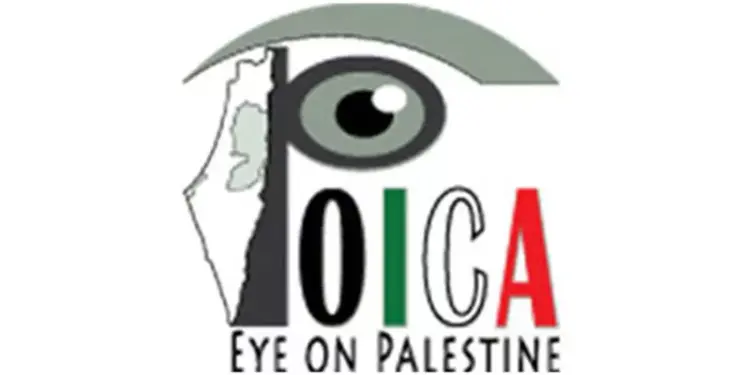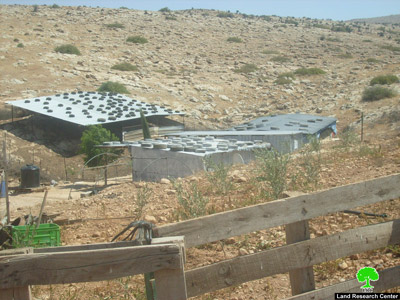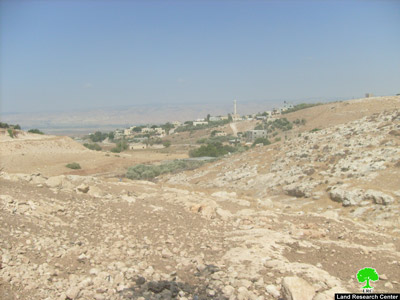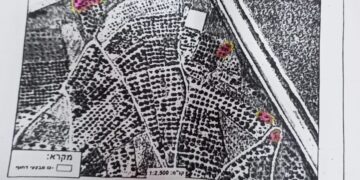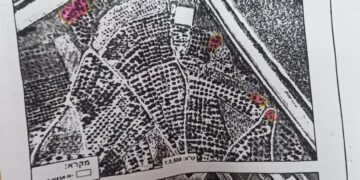Violation:
Date: The 18th of July, 2010
Details:
The so-called Building and Organization Committee of the Israeli occupation’s “Civil Administration” raided the village of Bardala on the said date accompanied by a large number of Israeli occupation forces. An officer in the “Civil Administration” notified 9 Palestinians that there are written Stop Works orders issued against their agricultural and residential structures in the village. The orders were issued under the pretext of building in an area classified as Area C without a permit from the Israeli authorities.
Pic.1: Some of the threatened structures – Bardala
The orders provided a time period until the 19th of August, 2010, for the structures owners to come to court the court in Bet El for the purpose of “starting the needed procedures to be issued the needed permits” from the Israeli occupation authority.
At the same time that the Stop Work orders were delivered, another eviction order was submitted to Mr. Khaled Rushdi Sawafta instructing him to vacate his residency place as it is located in “a Closed Military Zone,” according to the order. It should be pointed out that the indicated area is located not more than 40 meters away from the houses in the eastern side of the village. Mr. Sawafta owns a shelter made out of zinc in addition to 5 agricultural bruxes and a warehouse used to store fodder for his animals. Occupation forces gave him only 24 hours to remove the structures on his own. Otherwise, he was threatened to face similar fate like the structures in Al Farisiyya.
The following table provides general information regarding the newly-delivered 10 orders:
|
No.
|
Name
|
Area
|
No. of Structures
|
Family Members
|
Children
|
Type of Structures
|
Order Type
|
Order No.
|
|
1
|
Mohammad Tahseen Hasan
|
120
|
1
|
1
|
–
|
1-story houses ready to be inhabited
|
Stop Work
|
|
|
2
|
Mahmoud Tahseen Hasan
|
100
|
1
|
2
|
–
|
Under-construction basement
|
Stop Work
|
|
|
3
|
Mohammad Awwad Rashayda
|
140
|
1
|
9
|
7
|
Under-construction house
|
Stop Work
|
|
|
4
|
Ahmad Khneifis Rashayda
|
280
|
2
|
9
|
2
|
2-story house under construction
|
Stop Work
|
|
|
5
|
Khaled Rushdi Sawafta
|
0
|
7
|
7
|
2
|
Zinc shelter, 5 agricultural bruxes and a fodder storage.
|
Evacuation from a Closed Military Area
|
|
|
6
|
Mahmoud Faleh Rabaya’a
|
80
|
1
|
6
|
2
|
Sheep brux
|
Stop Work
|
|
|
7
|
Ra’afat Faleh Rabaya’a
|
90
|
1
|
2
|
|
Sheep brux
|
Stop Work
|
|
|
8
|
Hussein Faleh Rabaya’a
|
45
|
1
|
5
|
2
|
Sheep brux
|
Stop Work
|
|
|
9
|
Hazza’a Faleh Rabaya’a
|
80
|
1
|
7
|
2
|
Sheep brux
|
Stop Work
|
|
|
10
|
Faleh Mahmoud Rabaya’a
|
70
|
1
|
4
|
2
|
Sheep brux
|
Stop Work
|
|
|
TOTAL
|
1005
|
14
|
52
|
19
|
|
|
|
The Village of Bardala:
The village is located north east of the Jordan Valley at a distance of 24 kilometers east of the city of Tubas in Tubas Governorate. It is bounded by the village of Tayaseer in the west, Ein Al Beida in the north, the Jordan River in the east and Ein Al Maleh in the south.
Pic.2+3: A general view of the village of Bardala
The overall area of the village is about 31,000 dunums distributed as follows; 7,000 dunums are currently located behind and beneath the Racist Israeli Segregation Wall. The surface area of the village itself is only 350 dunums, 250 dunums covered with Green Houses, 100 dunums of irrigated trees while an additional 54 dunums were confiscated by the Israeli occupation authorities for the benefit of By-Pass Road 90. An additional 12,000 dunums are used for non-irrigated plants while an additional 10,000 dunums are planted with irrigated vegetables. The remaining lands are used for grazing purposes.
The population of the village, according to the figures of PCBS for the year 2009, stands at 2,154. About 99% of the population depends on agriculture and raising livestock as the two main sources of income. There are about 5,000 sheep in the village.
It is worth mentioning that the population of Bardala has its roots from the city of Tubas. A large number of the city folks moved to Bardala due to the presence of grazing areas and spring water. The main clan in the village is the clan of Sawafta while 10% of the population is wandering Bedouin families.


